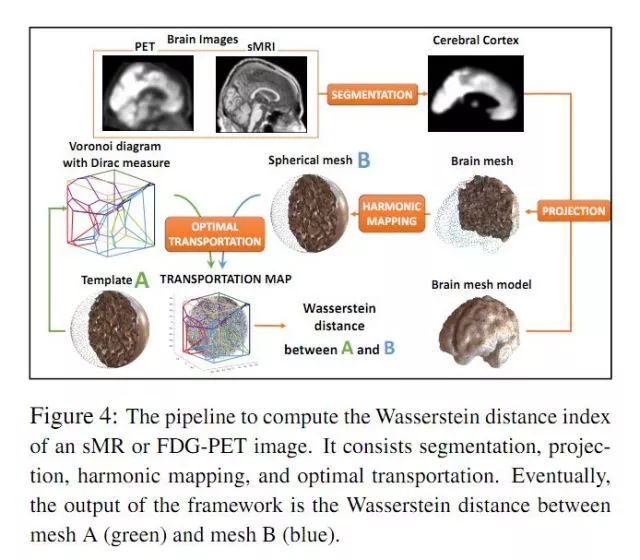【泡泡一分钟】 一种基于最优运输的单变量神经图像指数(ICCV2017-20)
每天一分钟,带你读遍机器人顶级会议文章
标题:An Optimal Transportation based Univariate Neuroimaging Index
作者:Liang Mi,Wen Zhang,Junwei Zhang,Yonghui Fan,Dhruman Goradia,Kewei Chen,Eric M. Reiman,Xianfeng Gu,Yalin Wang
来源:ICCV 2017 ( IEEE International Conference on Computer Vision )
播音员:格子
编译:杨雨生
欢迎个人转发朋友圈;其他机构或自媒体如需转载,后台留言申请授权
摘要

大脑结构和功能的改变,被认为与神经组织退化性疾病(如阿尔茨海默氏病)导致的认知表现的改变具有密切的关系。本文中,作者提出了一种变量框架来计算三维空间的最优变换(optimal transformation,OT),然后提出一种单变量神经成像指数(univariate neuroimaging index)来量化这种改变。作者首先计算每一张图片到模板之间的最优变换,然后测量他们之间的Wasserstein距离,通过比较所有图片到模板之间的距离,可以获得每张图片的信息标签。作者的框架利用牛顿法来减少计算量,从而适用于大规模数据集。本文所提出的框架具有普适性,可以应用在各类脑容积图像上,包括结构磁共振(sMR)图像, 氟脱氧葡萄糖正电子发射断层扫描(FDG-PET)图像。在Alzheimers Disease Neuroimaging Initiative(ADNI)数据库Smri数据集中,利用作者提出的指标对阿尔茨海默病患者和健康人员进行分类,作者的方法达到82.30%的准确率,超过了利用其他指标进行分类的方法。在FDG-PET数据集中,作者利用成对的Wasserstein 距离,将分类的准确性提高到了88.37%。作者提出的方法在神经图像分析和精密医学研究方面具有巨大的潜力。
Wasserstein距离是用来度量空间上两个概率分布之间的相似度,大脑图像可以被看作是3D概率分布,它提供了将Wasserstein距离应用于脑图像的可能性,以量化人脑的形状和功能变化。下图展示了如何计算sMR或者FDG-PET图片的Wasserstein距离。
Abstract:
The alterations of brain structures and functions have been considered closely correlated to the change of cognitive performance due to neurodegenerative diseases such as Alzheimer’s disease. In this paper, we introduce a variational framework to compute the optimal transformation(OT) in 3D space and propose a univariate neuroimaging index based on OT to measure such alterations. We compute the OT from each image to a template and measure the Wasserstein distance between them. By comparing the distances from all the images to the common template, we obtain a concise and informative index for each image. Our framework makes use of the Newton’s method, which reduces the computational cost and enables itself to be applicable to large-scale datasets. The proposed work is a generic approach and thus may be applicable to various volumetric brain images, including structural magnetic resonance (sMR) and fluorodeoxyglucose positron emission tomography (FDG-PET) images. In the classification between Alzheimer’s disease patients and healthy controls, our method achieves an accuracy of 82.30% on the Alzheimers Disease Neuroimaging Initiative (ADNI) baseline sMRI dataset and outperforms several other indices. On FDG-PET dataset, we boost the accuracy to 88.37% by leveraging pairwise Wasserstein distances. In a longitudinal study, we obtain a 5% significance with p-value = 1.13×105 in a t-test on FDG-PET. The results demonstrate a great potential of the proposed index for neuroimage analysis and the precision medicine research.
如果你对本文感兴趣,想要下载完整文章进行阅读,可以关注【泡泡机器人SLAM】公众号(paopaorobot_slam)。
链接: https://pan.baidu.com/s/1hHc23cKXjOaGMMdBuLdgVg
欢迎来到泡泡论坛,这里有大牛为你解答关于SLAM的任何疑惑。
有想问的问题,或者想刷帖回答问题,泡泡论坛欢迎你!
泡泡网站:www.paopaorobot.org
泡泡论坛:http://paopaorobot.org/forums/
泡泡机器人SLAM的原创内容均由泡泡机器人的成员花费大量心血制作而成,希望大家珍惜我们的劳动成果,转载请务必注明出自【泡泡机器人SLAM】微信公众号,否则侵权必究!同时,我们也欢迎各位转载到自己的朋友圈,让更多的人能进入到SLAM这个领域中,让我们共同为推进中国的SLAM事业而努力!
商业合作及转载请联系liufuqiang_robot@hotmail.com







